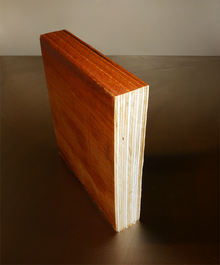Laminated veneer lumber (LVL) is an engineered wood product that uses multiple layers of thin wood assembled with adhesives. It is typically used for headers, beams, rimboard, and edge-forming material. LVL offers several advantages over typical milled lumber: Made in a factory under controlled specifications, it is stronger, straighter, and more uniform. Due to its composite nature, it is much less likely than conventional lumber to warp, twist, bow, or shrink.
LVL belongs to the category of engineered wood called structural composite lumber. Other members of this category are parallel strand lumber (PSL) and laminated strand lumber (LSL). All members of this category are strong and predictable, and are thus interchangeable for some applications. PSL is made from veneers that are cut up into long strands and oriented parallel to its length before compressed into its final shape. LSL is also made from strands rather than veneer, although the strands are shorter and aligned with less precision than PSL and is created as billets that are like a thick version of oriented strand board.
Innowood
Innowood is a composite reconstituted wood based material primarily made of timber used for internal and external applications. It is made from recycled wood waste and polymeric resins used in composite building and architectural products in Australia. The profile of Innowood has natural timber finish and texture with lesser weight. Innowood was introduced by an Australian John Kozlowski, founder of Innowood Australia Pty Ltd and it was used in composite building and products to reduce installation costs by concealed fixing and fastening systems.
Parallel Strand Lumber
- Wikipedia
Laminated veneer lumber detail
Laminated veneer lumber is similar in appearance to plywood without cross bands and is typically rated by the manufacturer for elastic modulus and allowable bending stress. Common elastic moduli are 1,800,000 psi (12,000 MPa); 1,900,000 psi (13,000 MPa); and 2,000,000 psi (14,000 MPa); and common allowable bending stress values are 2,800 psi (19 MPa); and 3,000 psi (21 MPa).
LVL is commonly manufactured in North America by companies that also manufacture I-joists. LVL is manufactured to sizes compatible with the depth of I-joist framing members for use as beams and headers. Additionally, some manufacturers further cut LVL into sizes for use as chord-members on I-joists. In 2012, North American LVL manufacturers produced more than 43.4 million cubic feet (1.2 million cubic meters) of LVL in 18 different facilities, and in 2013 the production increased with more than 14%.
Because it is specifically sized to work with I-joist floor framing, residential builders and building designers like the combination of I-joist and LVL floor and roof assemblies. LVL is a highly reliable building material that provides many of the same attributes associated with large sized timbers.
Structure Laminated LumberLVL belongs to the category of engineered wood called structural composite lumber. Other members of this category are parallel strand lumber (PSL) and laminated strand lumber (LSL). All members of this category are strong and predictable, and are thus interchangeable for some applications. PSL is made from veneers that are cut up into long strands and oriented parallel to its length before compressed into its final shape. LSL is also made from strands rather than veneer, although the strands are shorter and aligned with less precision than PSL and is created as billets that are like a thick version of oriented strand board.
Innowood
Innowood is a composite reconstituted wood based material primarily made of timber used for internal and external applications. It is made from recycled wood waste and polymeric resins used in composite building and architectural products in Australia. The profile of Innowood has natural timber finish and texture with lesser weight. Innowood was introduced by an Australian John Kozlowski, founder of Innowood Australia Pty Ltd and it was used in composite building and products to reduce installation costs by concealed fixing and fastening systems.
Parallel Strand Lumber
Parallam is the brand name for an engineered wood product invented, developed, commercialized and patented by MacMillan Bloede (now Weyerhaeuser) .The generic name for the product is parallel strand lumber (PSL). Parallam is made from clipped veneer strands laid in parallel alignment and bonded with adhesive. It is used for beams, headers, columns, and posts, among others uses. Parallam is the world's only commercially manufactured and marketed parallel strand lumber product. It is a member of the structural composite lumber (SCL) family of engineered wood products.
The product is manufactured as a 12" x 12" or 12" x 18" billet in a rectangular cross-section, which is then typically sawn and trimmed to smaller cross-sectional sizes. The beams are continuously formed, so the length of the beam is only limited to the maximum length that can be handled and transported. Typical thicknesses are 3½", 5¼” or 7"; typical depths are 9½", 11⅞" 14", 16" & 18". Typically the beams are made to a maximum length of 60 feet.
The design values for Parallam, in bending, tension parallel to grain and compression parallel to grain are greater than sawn lumber made from the same or similar species. This is because knots and other imperfections are randomly dispersed throughout the product so that strength variability from one piece to another is less than in solid-sawn wooden beams. Since materials are commonly graded to the lowest 5th percentile of the material's strength curve, this gives Parallam much higher usable strength. Parallam can be made from any wood species, but Douglas-fir, southern pine, western hemlock, and yellow-poplar are commonly chosen because of their superior strength.
- Wikipedia






No comments:
Post a Comment